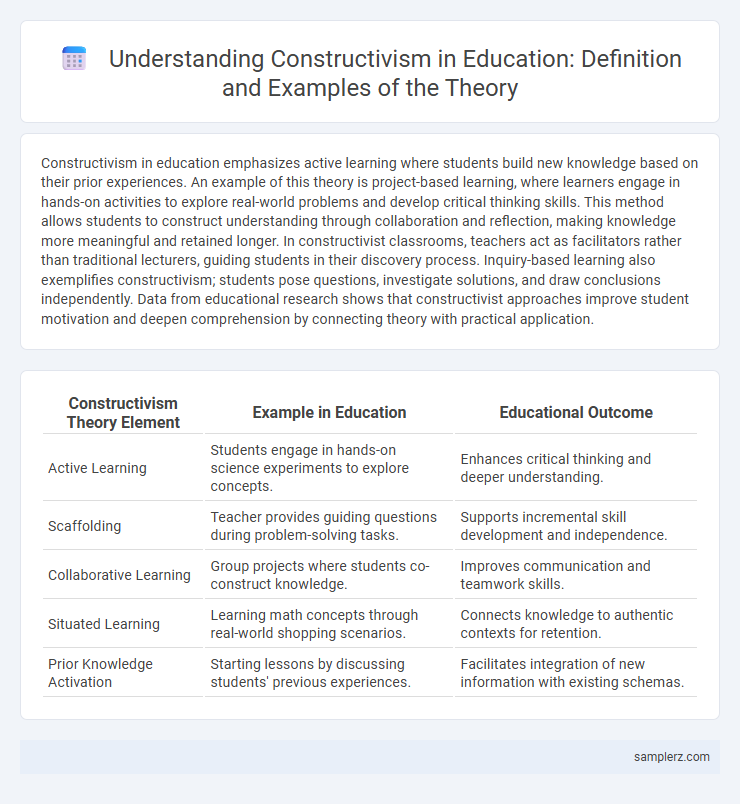Constructivism in education emphasizes active learning where students build new knowledge based on their prior experiences. An example of this theory is project-based learning, where learners engage in hands-on activities to explore real-world problems and develop critical thinking skills. This method allows students to construct understanding through collaboration and reflection, making knowledge more meaningful and retained longer. In constructivist classrooms, teachers act as facilitators rather than traditional lecturers, guiding students in their discovery process. Inquiry-based learning also exemplifies constructivism; students pose questions, investigate solutions, and draw conclusions independently. Data from educational research shows that constructivist approaches improve student motivation and deepen comprehension by connecting theory with practical application.
Table of Comparison
| Constructivism Theory Element | Example in Education | Educational Outcome |
|---|---|---|
| Active Learning | Students engage in hands-on science experiments to explore concepts. | Enhances critical thinking and deeper understanding. |
| Scaffolding | Teacher provides guiding questions during problem-solving tasks. | Supports incremental skill development and independence. |
| Collaborative Learning | Group projects where students co-construct knowledge. | Improves communication and teamwork skills. |
| Situated Learning | Learning math concepts through real-world shopping scenarios. | Connects knowledge to authentic contexts for retention. |
| Prior Knowledge Activation | Starting lessons by discussing students' previous experiences. | Facilitates integration of new information with existing schemas. |
Foundations of Constructivism in Educational Theory
Constructivism in educational theory emphasizes active learner engagement where students build knowledge through experiences and reflection. Key foundations include Piaget's cognitive development stages and Vygotsky's social interaction and scaffolding concepts, which highlight the importance of context and collaboration in learning. This theory supports student-centered teaching methods that encourage exploration, questioning, and problem-solving to deepen understanding.
Key Tenets of Constructivist Learning
Constructivist learning emphasizes active student engagement where learners build new knowledge upon prior experiences, reflecting Piaget's cognitive development theory and Vygotsky's social interaction concept. Key tenets include scaffolding, promoting learner autonomy, and encouraging collaborative problem-solving to deepen understanding. This approach fosters critical thinking and meaningful knowledge construction within authentic contexts.
Piaget’s Cognitive Constructivism: Principles and Examples
Piaget's Cognitive Constructivism emphasizes learning as an active process where students build knowledge through experiences and interaction with their environment. Core principles include assimilation, accommodation, and the development of schemas, leading to deeper understanding as learners adjust their mental models. Examples in education involve hands-on activities like experiments and problem-solving tasks that encourage discovery and cognitive development aligned with students' developmental stages.
Vygotsky’s Social Constructivism: Theory in Practice
Vygotsky's Social Constructivism emphasizes the role of social interaction and cultural tools in cognitive development, where learning occurs through collaborative dialogue within the Zone of Proximal Development (ZPD). Practical application involves scaffolding, where educators provide guidance and gradually reduce support as students gain independence in problem-solving. This approach fosters critical thinking and deeper understanding by encouraging peer collaboration and active engagement with culturally relevant materials.
The Role of Prior Knowledge in Constructivist Classrooms
Constructivist classrooms emphasize the critical role of prior knowledge by encouraging students to connect new information with existing cognitive frameworks, facilitating deeper understanding. Teachers design lessons that activate and build on students' previous experiences, promoting active engagement and meaningful learning. Research shows that this approach enhances critical thinking skills and knowledge retention by making learning relevant and personalized.
Collaborative Learning: Applying Constructivist Concepts
Collaborative learning exemplifies constructivist theory by encouraging students to actively engage in group discussions and problem-solving tasks, fostering deeper understanding through social interaction. This approach leverages the constructivist principle that knowledge is constructed through shared experiences and dialogue, enabling learners to co-create meaning. Studies show collaborative learning enhances critical thinking, retention, and motivation by situating knowledge within real-world contexts.
Inquiry-Based Learning as a Constructivist Approach
Inquiry-Based Learning exemplifies constructivism by encouraging students to actively explore questions and problems, fostering deeper understanding through hands-on investigation. This approach emphasizes student-centered discovery, critical thinking, and concept application, aligning with Jean Piaget's theory of cognitive development and Lev Vygotsky's social constructivism. Educational strategies such as project-based tasks and collaborative inquiry promote knowledge construction, enabling learners to connect new information with prior experiences effectively.
Scaffolding Techniques in Constructivist Education
Scaffolding techniques in constructivist education involve providing students with tailored support to bridge their current knowledge and new concepts, enhancing active learning and problem-solving skills. Teachers use guided questioning, modeling, and feedback to gradually transfer responsibility to the learner, promoting independent thinking and deeper comprehension. This approach aligns with Vygotsky's Zone of Proximal Development, emphasizing social interaction and cognitive growth through collaborative learning experiences.
Authentic Assessment: A Constructivist Perspective
Authentic assessment in education exemplifies constructivist theory by emphasizing real-world tasks that require students to actively apply knowledge and critical thinking skills. This approach encourages learners to construct meaning through experiential learning, reflection, and problem-solving in contexts relevant to their lives. By focusing on performance-based evaluations, authentic assessment fosters deeper understanding and promotes the development of transferable skills.
Integrating Technology to Support Constructivist Learning
Integrating technology in constructivist learning environments enhances student engagement through interactive simulations, virtual labs, and collaborative platforms that promote active knowledge construction. Tools like digital storytelling apps and problem-solving software enable learners to connect new information with prior experiences, fostering deeper understanding and critical thinking. Technology also facilitates personalized learning pathways, encouraging exploration and reflection that align with constructivist principles.

example of constructivism in theory Infographic
 samplerz.com
samplerz.com